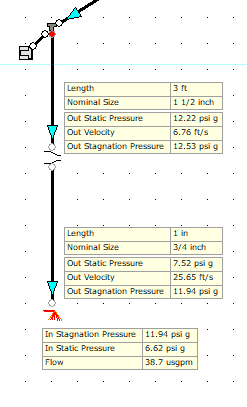Hi fellow members.
I am working on designing a wet pipe fire sprinkler system for a small room and I am using "Fluidflow software" to perform the hydraulic calculations. I am stuck at a very simple concept but I need your help in clarifying that. Sprinkler manufacturers recommend that the sprinkler operate at or above a minimum residual (flowing) pressure of 7 psi. Now my question is, when we look at the pressure available at the sprinkler head, do I look at the stagnation pressure or the static pressure? For example, for one of the most remote sprinklers, the stagnation pressure is coming out to be 7.72 psig and static pressure is 2.35 psig. Should I be comparing the stagnation pressure (7.72 psig) to the min. requires pressure (7 psig)? Appreciate the help and support.
I am working on designing a wet pipe fire sprinkler system for a small room and I am using "Fluidflow software" to perform the hydraulic calculations. I am stuck at a very simple concept but I need your help in clarifying that. Sprinkler manufacturers recommend that the sprinkler operate at or above a minimum residual (flowing) pressure of 7 psi. Now my question is, when we look at the pressure available at the sprinkler head, do I look at the stagnation pressure or the static pressure? For example, for one of the most remote sprinklers, the stagnation pressure is coming out to be 7.72 psig and static pressure is 2.35 psig. Should I be comparing the stagnation pressure (7.72 psig) to the min. requires pressure (7 psig)? Appreciate the help and support.

